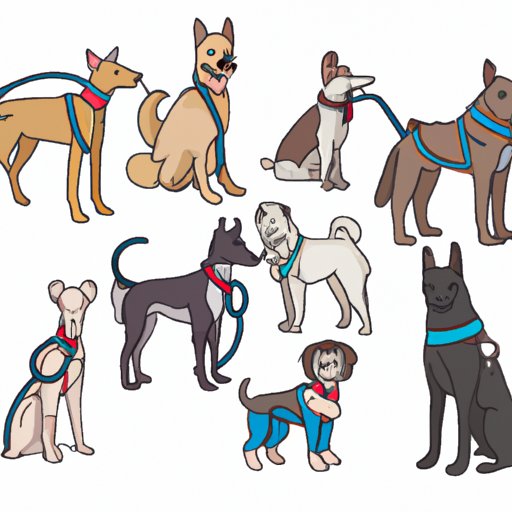
Introduction
As a pet owner, it’s important to know how to put on a dog harness correctly, as this will keep your furry friend safe and comfortable. A harness is a safer alternative to a collar since it reduces the risk of neck injuries and choking, especially for small breeds. In this article, we’ll guide you on how to properly put on a dog harness, explain the benefits of using one, highlight common mistakes to avoid, and discuss the different types of harnesses available on the market.
The Step-by-Step Guide
The first step in putting on a dog harness is to unbuckle it and lay it flat on the ground. Place your dog’s front paws through the two holes. The harness should rest against their chest.

Next, bring the two ends of the harness up around your dog’s back and then clip the two sides together. Make sure the buckles are securely fastened, but not too tight. There should be enough room for you to fit two fingers between the harness and your dog’s skin.

Continue to adjust any straps or buckles around the neck, chest, and torso to ensure a snug fit. Check that the harness is comfortable and your dog can move freely. Finally, attach the leash to the D-ring on the back of the harness. The harness should be snug, but not too tight, and positioned correctly for your dog’s size and needs.

The Benefits of Using a Harness
Using a harness rather than a collar can offer additional safety and comfort for your dog. A harness distributes the pressure across your dog’s chest and shoulders, rather than their neck. This means there’s less risk of choking, gagging, or neck injuries, especially for small breeds or dogs with respiratory problems. A harness also gives you greater control over your dog’s movements, while keeping them safe and secure when you’re out and about.
Ensure you measure your dog’s girth accurately, so you get the right size harness. A proper fit should be snug around your dog’s chest, but have enough space to prevent rubbing or restricting movement.
Common Mistakes and How to Avoid Them
It’s important to avoid common mistakes when putting on a harness, to keep your dog safe and comfortable. Common mistakes include fastening the harness too tightly, placing the harness on the dog’s back instead of chest, or using a harness that doesn’t properly fit your dog.
To avoid these mistakes, start by selecting the correct harness size for your dog’s measurements. Allow your dog time to get used to wearing a harness and avoid tugging or pulling on the leash. Always check harness alignment and placement to ensure proper fit and safety for your dog.
Types of Dog Harnesses Available
There are different types of dog harnesses available in the market, designed to meet different needs, preferences, and sizes of dogs. Some common types of harnesses include front-clip, back-clip, and adjustable harnesses.
Front-clip harnesses offer more control when walking your dog and discourages pulling. Back-clip harnesses provide greater comfort and can work well for smaller dogs or those prone to respiratory problems. Adjustable harnesses can be suited for dogs who fall in between sizes and allow for a better fit.
Training Your Dog to Wear a Harness
It’s important to introduce your dog to a harness gradually, allowing them to feel confident and comfortable wearing it. Start by letting your dog sniff the harness, then putting it on their back before gradually fastening the buckles. Reward your dog with treats or praise for a positive experience. Repeat the process daily until your dog is comfortable wearing the harness.
To build up your dog’s confidence, attach the leash to the harness and allow your dog to move around. You can also take short walks around a secure area, rewarding your dog for positive behavior and good leash manners. Eventually, your dog will associate the harness with positive experiences and will be more willing to wear it regularly.
Conclusion
If you’re a pet owner, it’s crucial to understand how to properly put on a dog harness, to keep your furry friend safe and comfortable. A harness is a safe and comfortable alternative to a collar, and offers greater control and support while walking your dog.
Remember to select the correct size and style of harness, introduce the harness to your dog gradually, and check the fit regularly to ensure your dog’s comfort and safety. Share this article with other dog owners, who may be struggling to find the right harness for their furry friend, and help keep dogs safe, happy, and healthy.




